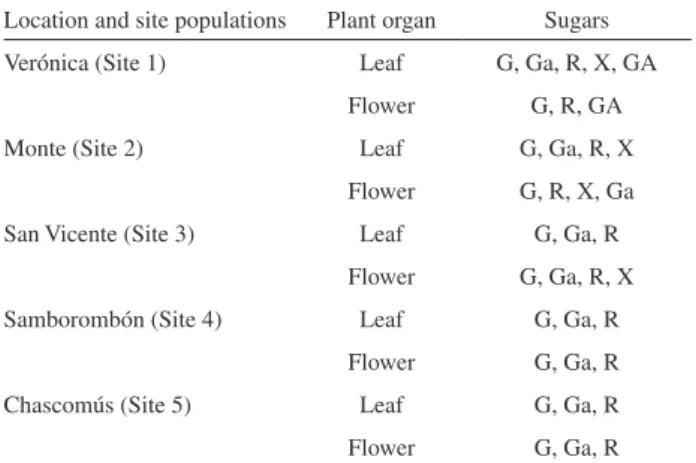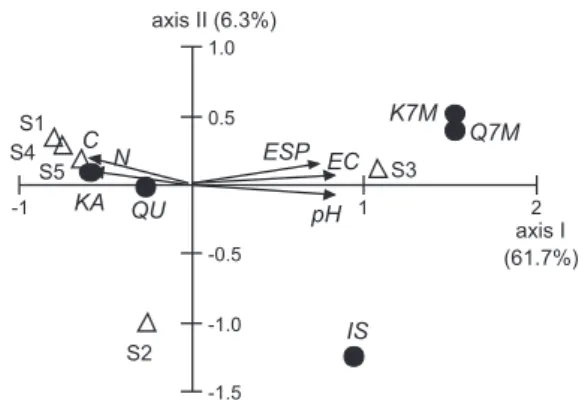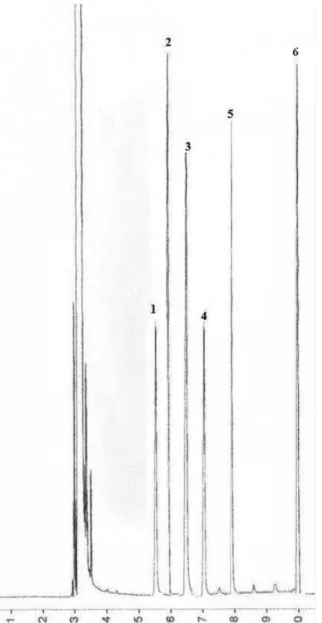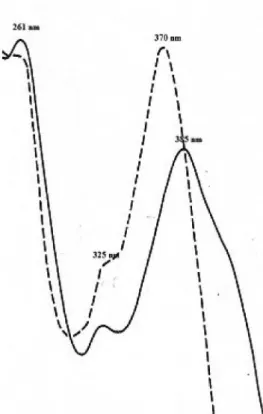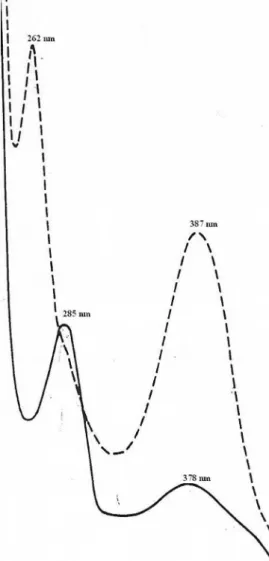Ar
ti
cle
0103 - 5053 $6.00+0.00
*e-mail: rilip@ffyb.uba.ar
Flavonoids of Lotus tenuis (Waldst. & Kit.) as Markers of Populations Growing
in Soils of Different Saline and Hydrologic Conditions
Graciela Ferraro,a Rosana Filip,*,a María A. del Pero,a Norma Basualdo,a Rodolfo Mendozab and Ileana Garcíab
aPlant Physiology, School of Pharmacy and Biochemistry, IQUIMEFA (UBA-CONICET), University of Buenos Aires, Junín 956, 1113 Buenos Aires, Argentina
bBernardino Rivadavia, Argentine Museum of Natural Sciences (CONICET), Av. Ángel Gallardo, 470, 1405 Buenos Aires, Argentina
Lotus tenuis Waldst. et Kit. (=Lotus glaber Mill.) é uma planta leguminosa muito difundida que cresce naturalmente em pastagens da Flooding Pampas, na Argentina. Uma das hipóteses para explicar a disseminação de L. tenuis nessa área, é a diferenciação de ecotipos. O objetivo deste trabalho foi investigar os compostos lavonoides presentes em populaçõesde L. tenuis que crescem em uma grande variedade de solos. Amostras de cinco populações que crescem em solos com diferentes características foram coletados, cultivados em estufas e comparados de acordo com seu peril de lavonoides. Glicosídeos dos seguintes lavonoides foram detectados: quercetina, 7-metóxi-quercetina éter, kaempferol, 7-metóxi-kaempferol éter e isorhamnetina. Somente as mostras de solos salino-sódicos mostraram agliconas metiladas: 7-metóxi-kaempferol éter e 7-metóxi-quercetina éter. Os últimos compostos poderiam, portanto, ser considerados como a expressão de uma adaptação bioquímica e sugerem uma diferenciação em ecotipo.
Lotus tenuis Waldst. et Kit. (=Lotus glaber Mill.) is a widely spread leguminous plant which grows naturally in low grasslands of the Flooding Pampas of Argentina. One of the hypothesis to explain the succesful spread of L. tenuis in this area, is the ecotypes differentiation. The aim of this work was to investigate the lavonoid compounds present in L. tenuis plant populations which grow in a variety of soils. Individuals from ive populations growing in soils having different characterisctics were collected, cultivated in a glasshouse and compared according to their lavonoid proile. Glycosides of the following lavonoids were detected: quercetin, quercetin 7-methyl ether, kaempferol, kaempferol 7-methyl ether and isorhamnetin. Only those samples from a saline-sodic lowland, showed methylated aglycones: kaempferol 7-methyl ether and quercetin 7- methyl ether. The latter compounds could therefore be considered the expression of a biochemical adaptation and suggest an ecotype differentiation.
Keywords: Lotus tenuis, lavonoids, ecotype, environment adaptation, soil gradient
Introduction
Species of the genus Lotus are increasingly used in pastures over the world because of their plasticity and productivity in a wide range of soils.1Lotus tenuis Waldst. & Kit. (Lotus glaber Mill.) is a widely spread leguminous plant which grows naturally in the low grasslands of a region known as the Flooding Pampas of Argentina.2 It is highly esteemed by farmers because it is a source of nutritive forage for beef and dairy cattle in a normally
nutrient deicient soils which are poor for agricultural purposes. The productivity of the grasslands in the Flooding Pampas is strongly affected by stress factors such as salinity, sodicity and an excess or deicit of water in soil, depending upon the climate and season. Thus, the presence of L. tenuis in those plant communities is crucial for the quality of the native grassland for cattle, especially in winter.3,4
by morphological attributes5 but also by their different capacity to absorb phosphorus from soils deficient in this.6 While L. tenuis is adapted to low fertility conditions, it is highly dependent on arbuscular mycorrhiza symbiosis to grow at low phosphorus availability in the soil.7 This symbiotic association could be one of the explanations for the successful adaptation of Lotus to the variety of nutrient-deicient soils encounteredin the Flooding Pampas.
The richness and diversity of lavonoid compounds in Lotus species tissues has been demonstrated and some authors have used lavonoids as speciation markers within
Lotus species.8 Flavonoids have been successfully used to differentiate seeds of L. tenuis from L. corniculatus,9 suggesting that these compounds might be important markers for distinguishing populations or ecotypes. Preliminary studies have demonstrated the presence of different lavonoid compounds in the leaves of L. tenuis
collected along a saline-sodic gradient.10 Flavonoid extracts from roots and shoots of white clover revealed that the compositions of the lavonoid mixtures varied with soil growing conditions and quercetin, acacetin and rhamnetin accumulated in roots of arbuscular mycorrhizas inoculated plants, whereas they were not detected in non-inoculated plants.11 The synthesis of lavonoids appears to increase the presence of arbuscular mycorrhiza even before colonization.12
The aim of this work was to investigate the distribution of lavonoids in L. tenuis plant communities in populations of the Flooding Pampas in an attempt to provide a means of differentiation of the ecotypes which grow in a variety of soils.
Experimental
Lotus tenuis populations
The Flooding Pampas is a grassland with a surface of 90,000 km2, which extends along the Atlantic coast from the NW to the SE of the Buenos Aires Province in Argentina (34°50’ to 37°40’S; 56°40’ to 61°00’W).
Out of a total of 18 grassland sites of the Flooding Pampas in Buenos Aires Province, 5 were selected based on their different soil characteristics such as: pH, phosphorus (P) status, salinity, hydrologic condition during the year and the presence of L. tenuis in the plant community. There is a high variability in soil characteristics among the soil sites sampled (Table 1). Site 1 (Verónica) is an abandoned disturbed pasture with acidic soil, high clay content and dominated by
L. tenuis, Phyla canescens (H.B.K.) Greene, Eryngium
ebracteum Lam. and Piptochaetium bicolor (Vahl) Desv.
Sites 2 (Monte), 3 (San Vicente), 4 (Samborombón) and 5 (Chascomús) are all frequently grazed natural grasslands. Site 2 is a sandy lowland of neutral soil pH dominated by
L. tenuis, Ambrosia tenuifolia Spreng., Cyperus laetus C. Presl. and Juncus microcephalus H.B.K. Site 3 is a typical saline-sodic lowland, frequently looded and dominated by L. tenuis, Distichlis spicata (L) Greene., Eleocharis viridans Kükenth and Cynodon dactylon (L) Pers. In Site 4, L. tenuis, Stenotaphrum secundatum (Walt.) O.K., Lolium multilorum Lam., Stipa paposa Nees. and
Paspalum dilatatum Poir are predominant, whereas in Site 5, L. tenuis, Bothriochloa laguroides (DC) Pilg., Paspalum
dilatatum Poir, and Carex sp., are the prevailing species. These latter two sites (4 and 5) are at an intermediate altitude topographic position between site 1 and 2 or 3. As voucher specimens, 5 individuals (shoots and roots) of
L. tenuis with undisturbed surrounding soil were collected at random in each of the 5 ield sites. These individuals were then transplanted into 5 L pots containing their native soils. Plants were grown in a glasshouse at 27 °C ± 5 °C during 10 months until lowering with a water content in the soil near to the ield capacity. Soil characteristics were determined as described by Jackson.13 Flavonoids from leaves and lowers proceeding from plants collected in the 5 locations were analysed. These locations were between 60 and 140 km apart and had different edaphic conditions, principally the pH, salinity, organic matter, nitrogen and phosphorus content and texture of the soil (Table 1). Additionally, the roots of L. tenuis plants collected from all the sites were analysed for arbuscular mycorrhiza colonization.14
Flavonoids investigation
2.0 g of plant material was heated under relux with 20 mL of 80% methanol overnight. The extract was iltered and the procedure was repeted twice. The extracts were combined and taken to dryness in a rotatory evaporator and redissolved in 5.0 mL of methanol.
2.0 mL of the methanolic extract were analysed by bidimensional chromatography on cellulose precoated plates with two mobile phases: BAW (n-butanol:acetic acid:water, 4:1:5, top layer used) (irst dimension) followed by 2% acetic acid (second dimension). The lavonoid glycosides were detected under UV light at 254 nm and 366 nm before and after fuming in NH3, following the maps indicated by Mabry et al.15
phases were pooled, evaporated to dryness and redissolved in 1.0 mL of methanol for aglycones investigation.
The aqueous phase was concentrated in a rotatory evaporator and reserved for sugars analysis.
For the aglycones investigation, 5.0 µL of the methanol extract were chromatograied on cellulose precoated thin layer plates using as mobile phase: (HCl:HOAc:H2O, 3:30:10) and 40% aqueous HOAc. The lavonoids were detected using UV at 365 nm and spray reagents according to Wagner and Bladt.16 The fraction was also subjected to one dimensional semipreparative TLC using cellulose plates and BAW (n-butanol:acetic acid:water, 4:1:5, top layer) as solvent. The standard flavonoids: quercetin, isorhamnetin and kaempferol were used as reference compounds. Subsecuently all the lavonoids were isolated and identiied by a combination of (i) colour characteristics on TLC plates under UV light before and after fuming in NH3 and spray reagents16 (ii) (Rf) values on TLC plates, (iii) co-chromatography with standard compounds and (iv) UV spectra and shifts reagent according to literature.15,17 For kaempferol 7-methyl ether and quercetin 7-methyl ether, their identities were conirmed by MS spectra; kaempferol 7-methyl ether (Ms: 300, 100%), quercetin 7-methyl ether (Ms: 316, 100%).17 The relative content of each constitutive lavonoid aglycone was estimated semi-quantitatively.
Analysis of sugars by GC-MS
The aqueous remaining phase was subjected to GC-MS analysis for the sugars study following the method described by Horbowics and Obendorf.18 Briely, samples were dried under N2 gas and stored overnight above P2O5 to remove traces of water. Dried residues were derivatised with 100 µL of 1-(trimethylsilyl) imidazole (TMSI): pyridine (1:1 v/v) and analysed on a GC-MS Clarus 500 (Perkin Elmer) and two capillary columns (J&W):
(i) polyethylene glycol (aprox. M.W. 20,000) and (ii) DB-5, both of 60 m × 0.25 mm, 25 µm of solid phase.
Multivariate analyses
The canonical correspondence analysis (CCA)
ordination technique by CANOCO program19 was
used. The CANOCO algorithm identiies the best linear combinations of soil properties that inluence the synthesis of a given lavonoid.
The concentration of ive lavonoids in both leaves and lowers tissues (10 observations) were analysed in L. tenuis
plants collected from the 5 sites and included in the main matrix. They were: kaempferol (KA), quercetin (QU), isorhamnetin (IS), kaempferol-7-methyl ether (K7M), and quercetin-7- methyl ether (Q7M). The second matrix was constituted by 5 soil properties from the 5 sites using a common value for leaves and lowers from the same site (10 observations): pH, total carbon (C), total nitrogen (N), exchangeable sodium percentage (ESP) and electrical conductivity (EC). The analysis allows identifying the best linear combinations of the environmental variables that inluence the lavonoid proile in plant tissue. To assess the signiicance in the CCA axes, the Monte Carlo simulation was used to test the hypothesis that there was no correlation between the main (lavonoids) and secondary (soil properties) matrixes. The P values were based on the proportion of 1000 Monte Carlo simulations with an Eigen value greater than the Eigen value observed.
Results and Discussion
Flavonoids composition
The L. tenuis populations analysed in this work proved to have lavonol derivatives exclusively (Figure 1). The
Table 1. Chemical and physical characteristics of the ive selected grassland sites of the Flooding Pampas in Buenos Aires province
Soil property Location and soil site
Verónica (Site 1) Monte (Site 2) San Vicente (Site 3) Samborombón (Site 4) Chascomús (Site 5)
pH (1:2.5) 5.63 ± 013 7.38 ± 1.10 9.03 ± 0.43 7.64 ± 0.45 5.60 ± 0.14
C (g kg-1)* 55.3 26.6 16.0 69.7 28.9
N (g kg-1)* 4.53 2.34 1.84 5.22 2.26
P Bray I (mg kg-1) 1.38 ± 0.31 6.23 ± 3.31 8.60 ± 2.37 6.88 ± 3.22 6.10 ± 2.65
EC (dS/m) 0.51 ± 0.28 1.93 ± 1.60 5.03 ± 0.37 1.52 ± 0.61 1.15 ± 0.52
ESP/(%) 7.30 24.42 81.22 27.84 25.57
Clay/(%)* 38.7 3.7 30.5 26.7 15.7
Loam/(%)* 52.4 9.6 51.4 60.2 51.1
Sand/(%)* 8.9 86.7 18.1 13.1 33.2
identified aglycones were: kaempferol, isorhamnetin (quercetin 4’-methyl ether), quercetin, quercetin 7-methyl ether and kaempferol 7- methyl ether (Table 2). A large variety of 3-0- mono, di, tri or tetraglycosides were observed (data not shown). Although the glycosidic sequence was not determined, the number and identity of the sugars were determined by GC-MS as: glucose, galactose, rhamnose, xylose and glucuronic acid. It was found that the differences in the type of sugars units obtained after hydrolysis of their glycosides, cannot be used for diagnostic purposes (Table 3).
The aglycones proile of the L. tenuis populations are shown in Table 2. Site 1 population was distinguished by the simple proile of leaf extracts, in which the main glycosides were kaempferol derivatives while quercetin glycosides were present at relatively low concentrations (0.1-0.5 µg g−1). Conversely, the lowers showed equal amounts of quercetin and kaempferol glycosides. The presence of glucuronic acid among the detected sugars is noteworthy since it was only found in samples from this population (Table 3).
Samples from site 2 showed similar content of kaempferol and quercetin glycosides in leaf and lower extracts. Flowers were also found to contain isorhamnetin glycosides.
The simplest leaf extract proile corresponded to samples of the leaf from site 4, in which kaempferol glycosides were the most abundant compounds (0.5-1.0 µg g−1). The lower extracts contained more glycosides than the leaf extract. It is important to note that kaempferol is the major aglycone in both leaf and lower extracts.
Plant material from site 5 was the only one that contained glycosides of kaempferol and quercetin with a clear prevalence of quercetin as aglycone in both, leaf and lower extracts.
Samples from site 3 population showed a different quali and quantitative lavonoid proile from all the other samples.
Figure 1. Structural representations of lavanols identiied in this study.
Table 2. Distribution pattern of lavonoids at the ive selected populations in different organs of L. tenuis plants Location and site populations Plant organ Flavonoid Aglycones
1 2 3 4 5
Verónica (Site 1) Leaf +++ + - -
-Flower +++ +++ - -
-Monte (Site 2) Leaf ++ ++ - -
-Flower ++ ++ ++ -
-San Vicente (Site 3) Leaf +++ +++ ++ +++ +++
Flower - +++ ++ +++
-Samborombón (Site 4) Leaf ++ + - -
-Flower +++ ++ - -
-Chascomús (Site 5) Leaf ++ +++ - -
-Flower ++ +++ - -
-The aglycones units were investigated after hydrolysis of glycosides 1: kaempferol; 2: quercetin; 3: isorhamnetin; 4: kaempferol 7-methyl ether; 5: quercetin 7- methyl ether. Approximate Aglycone amount: +++, 1.0-2.0 µg g-1; ++, 0.5-1.0 µg g-1; +, 0.1-0.5 µg g-1; -, less than 0.1 µg g-1. The values are the average
of four to ten determinations and are refered to dry plant material.
Table 3. Distribution of sugars after hydrolysis of glycosides from the ive selected populations in different organs of L. tenuis plants
Location and site populations Plant organ Sugars
Verónica (Site 1) Leaf G, Ga, R, X, GA
Flower G, R, GA
Monte (Site 2) Leaf G, Ga, R, X
Flower G, R, X, Ga
San Vicente (Site 3) Leaf G, Ga, R
Flower G, Ga, R, X
Samborombón (Site 4) Leaf G, Ga, R
Flower G, Ga, R
Chascomús (Site 5) Leaf G, Ga, R
Flower G, Ga, R
The leaf extracts were the richest in lavonoids, showing the major content of kaempferol and quercetin. This sample also contained glycosides from the methylated aglycones: isorhamnetin (quercetin 4’-methyl ether), kaempferol 7-methyl ether and quercetin 7-methyl ether in the highest amount found in all the samples analyzed. Interestingly, the lower extract proiles showed only quercetin and glycosides from the methylated aglycone isorhamnetin and kaempferol 7-methyl ether, but not kaempferol.
Additionally, the roots of the L. tenuis plants collected from the sites were all heavily colonized by arbuscular mycorrhizas, being colonized a 90-97% of root length.
Multivariate analyses
The Canonical Correspondence Analysis (CCA) ordination technique by CANOCO program19 was used to establish how the lavonoids aglycones (kaempferol (KA), quercetin (QU), isorhamnetin (IS), kaempferol 7-methyl ether (K7M), and quercetin 7-methyl ether (Q7M)) content in tissues of L. tenuis plants collected from different sites, are related to environmental factors. The CANOCO algorithm identiies the best linear combinations of soil properties that inluence lavonoids content.
Figure 2 shows the observations on the two first ordination axes of the CCA study. The two irst axes, indicators of the amount of lavonoids variation, explained the 68.0% of the total variance (axis I: 61.7% and axis II: 6.3%). The Pearson´s correlation coeficient between the scores of the irst two axes derived from the lavonoids data and the sample scores that are linear combined with environmental variables were 0.98 and 0.68 respectively,
being these values statistically signiicant. In addition, the Monte Carlo test indicated that the overall effect of the soil properties included in the second matrix and the irst canonical axis was signiicantly correlated at a probability P < 0.01. However, axis II did not correlate (P < 0.88). These results indicated that axis I is the most important one to describe the effect of the environment on lavonoids content in plant tissues.
In the irst matrix, axis I was positively correlated with K7M (P < 0.001), Q7M (P < 0.05) and IS (P < 0.01). Axis II was positively correlated with IS (P < 0.01). Figure 2 also shows that the different lavonoids were segregated to different quadrants. The two methylated lavonoids (kaempferol 7-methyl ether and quercetin 7-methyl ether) were displaced together to the upper right quadrant (K7M and Q7M); IS to the lower right quadrant and the other two lavonoids (KA and QU) were displaced to the left quadrants.
The ordination placed the observations separately by the location. Sites 1, 2, 4 and 5 were segregated to the negative scale of axis I; and site 3 to the positive scale of axis I (Figure 2). The biplots show the ordination of the soil variables of the second matrix (pH, EC, ESP, C and N) that were signiicantly correlated with the axes. The length of the vector describes the relative signiicance of the correlation of that variable with the axes and the angles between the vectors relect the inter-correlation between the variables. The angle between a vector and each axis is a representation of the degree of correlation with the corresponding axis. Thus, on the positive scale of axis I, pH (P < 0.01), EC (P > 0.001) and ESP (P < 0.001) were positively correlated with this axis but C (P < 0.05) and N (P < 0.05) were both negatively correlated.
Different associations emerged in separate parts of the diagram of Figure 2. Highest values of pH, CE and ESP in soil occurs to the positive scale of the axis I, associated with the presence of K7M and Q7M lavonoids in leaves and/ or lowers of L. tenuis plants. In addition, the observations from site 3 were also displaced to right side of axis 1 associated with high values of soil pH, CE and ESP. The arrows of the C and N status in soil are pointing to site 1, 4 and 5 closely associated with the presence of KA and QU in L. tenuis tissues.
The lavonoid glycosides composition of the samples was determined using a combination of chromatographic techniques and spectroscopic methods such as TLC, UV and MS spectra. Our survey and identiication of lavonoids was conducted using UV spectra and shifts reagents of acid-hydrolyzed ethyl acetate extracts to determine speciic lavonoid classes.15,17 The sugars identity was determined by GC-MS of the aqueous hydrolyzed extracts.
Figure 2. Ordination diagram from the Canonical Correspondence Analysis of L. tenuis populations based on lavonoids variables (main
matrix) and soil properties (secondary matrix). Sites were identiied
According to the results obtained in this work, it is possible to establish differences between the L. tenuis populations based on the structures of the flavonoid aglycones and their corresponding glycosides. Some authors have used lavonoids as speciation markers within the Lotus species8 and to differentiate seeds of L. tenuis from L. corniculatus,9 suggesting that these compounds might be important markers to distinguish populations or ecotypes.
A high variability in soil characteristics among the soil sites sampled was found (Table 1). Site 3 is a typical saline-sodic lowland having EC and ESP values higher than 4 dS/m and 15% respectively.20
Previous studies have suggested the existence of
L. tenuis ecotypes which can be differentiated from one another by some morphologic attributes5 but also by a different capacity to absorb phosphorus from P-deicient soils.6 Furthermore, Kade et al.21 have reported that the L. tenuis population growing in site 3 (saline-sodic) exhibited differences in the eficiency of P utilization with the population growing in site 1 (non saline, non sodic). In addition, L. tenuis from populations of site 3 showed longer shoots, internodes and lealets when compared to the ones belonging to the other ive populations (sites 1, 2 and 4 were included) when growing in both the original and a common soil.22 The authors concluded that these characteristics were due to the existence of a genetic control that suggested the presence of ecotypes adapted to speciic soil conditions.
The principal differences between sites are referred to the glycoside content and the type of chromatographic proile of the leaf and lower extracts. The population collected in site 1 is notable for the presence of glycosides with glucuronic acid residues, which is very rare and was not observed in other populations. This characteristic shows a remarkable difference with the population from site 3 coinciding with the differences in the observed morphological characteristics and their phosphorus absorbing capacity reported in previous works.21,22
According to the results obtained in this work, it is possible to establish differences between the populations based on the structure of the lavonoid aglycones and their glycosides. Differences in the aglycone composition were observed in populations from all the sites studied. In some cases the variation consisted in the type or in the amount of the different aglycones found; in other cases the differences were in the type and in the number of sugars obtained after hydrolysis of the glycosides, even when these results could not be used for diagnostic purposes.
Quantitative differences in the aglycone content were observed in populations from sites 1, 2, 4 and 5. In this sense, in populations 1 and 4 there is a predominance of
kaempferol glycosides, site 2 showed similar quantities of kaempferol and quercetin plus isorhamnetin glycosides and site 5 is the only one in which quercetin is clearly abundant in leaf and lower extracts.
The most outstanding feature related to the aglycone content is the presence of methylated structures such as the 7-methyl ethers of kaempferol and quercetin in site 3. These compounds were not identiied in any other population and are therefore characteristic of this one. This relects the expression of a characteristic or biochemical adaptation which requires the use of a more complex biosynthetic pathway that allows the modiication of the basic structure of the lavonols.
The CCA analysis was used to identify the best linear combinations of the environmental variables that inluence the lavonoids variables in plant tissues. The results obtained are in concordance with the phytochemical results. It is clear that the lavonoid proile of population from site 3 differed with the other populations sampled. The CCA study support this conclusion showing that quercetin 7-methyl ether and kaempferol 7-methyl ether present in leaves were particularly important in L. tenuis plants growing in soils of high pH, EC and ESP (Figure 2)
Taking into account our previous works21,22 and the results obtained herein, it could be deduced that the San Vicente (site 3) population represents an ecotype of very well deined soil chemical characteristics, plant morphological characters and distinguished by its eficiency to absorb phosphorus from the soil. Owing to their uniqueness it would be interesting to investigate the presence of the methylated lavonoids in roots or root exudates as they might be useful as markers to study interactions with mycorrhiza, specially considering that roots of L. tenuis growing in site 3 were heavily colonized by arbuscular mycorrhizas even when the site was looded during 7 months.23 It has been reported that lavonoid extracts from roots and shoots of white clover possess lavonoid mixtures which varied with soil growing conditions and quercetin, acacetin and rhamnetin were accumulated in roots of arbuscular mycorrhizas inoculated plants, whereas such compounds were not detected in non-inoculated plants.11 The synthesis of lavonoids appears to increase the presence of arbuscular mycorrhiza even before colonization.12 However, in the present work the roots of the L. tenuis plants collected from the sites were all heavily colonized by arbuscular mycorrhizas being colonized a 90-97% of root length. Thus, the differences in lavonoids content cannot be explained by differences in magnitudes of mycorrhizal colonization between Lotus populations.
soil, together with periods of flooding, render site 3 a very different habitat from all other sites. This fact might imply that the quali and quantitative differences of lavonoid content exhibited by L. tenuis plants growing in these environmental conditions could be attributed to the existence of a different ecotype in this site. In the future, it would be interesting to analyse whether there is a connection between the phosphorus content of
L. tenuis tissues and the type and amount of lavonoids detected in the plant, as a means to determine if ecotypes associated to different environments can be distinguished by their capacity to absorb and use the phosphorus which is available in the soil.6 In addition, this could provide an explanation of the successful spread and adaptation of L. tenuis in the Pampas, thus providing background information for future grassland management strategies.
Supplementary Information
Supplementary data are available free of charge at http://jbcs.sbq.org.br, as PDF ile.
Conclusions
Only those samples of L. tenuis populations of the “Flooding Pampas”collected from a saline-sodic lowland and poor in terms of soil conditions for plant growth, showed the methylated aglycones: kaempferol 7-methyl ether and quercetin 7-methyl ether. The different lavonoid proile obtained from samples which grow in a variety of soils could constitute an additional tool for distinguishing ecotypes, coinciding with the differences in the observed morphological characteristics.
References
1. Blumenthal, M. J.; McGraw, R. L.; Trefoil: The Science and
Technology of Lotus; American Society of Agronomy Inc.:
Wisconsin, USA, 1999.
2. Mazzanti, A.; Montes, L.; Minon, D.; Sarlangue, H.; Chepi, C.;
Rev. Argent. Prod. Anim. 1988,8, 301.
3. Rosso, O. R.; Gómez, P. O.; Rev. Argent. Prod. Anim. 1995,15,
364.
4. Cauhépe, M.; Lotus Newsletter 2004, 34, 30.
5. Stoffella, S. L.; Posse, G.; Collantes, M. B.; Ecologia Austral
1998, 8, 57.
6. Mendoza, R.; Pagani, E.; Pomar, M. C.; Ecologia Austral 2000,
10, 3.
7. Mendoza, R.; Pagani, E.; J. Plant Nutr.1997, 20, 625. 8. Reynaud L.; Lussignol M.; Lotus Newsletter 2005, 35, 75. 9. Kade, M.; Wagner, M. L.; Strittmatter, C. D.; Ricco, R. A.;
Gurni A. A.; Seed Sci. Technol. 1997, 25, 585.
10. Filip, R.; Ferraro, G.; Basualdo, N.; Mendoza, R. E.; García, I.;
Abstract of theXXX Jornadas Argentinas de Botánica, Rosario,
Santa Fe, Argentina, 2005.
11. Ponce, M. A.; Scervino, J. M.; Erra-Balsells, R.; Ocampo, J. A.; Godeas, A. M.; Phytochemistry2004, 65, 1925.
12. Larose, G.; Chênevert, R.; Moutoglis, P.; Gagné, S.; Piché, Y.; Vierheilig, H.; J. Plant Physiol.2002, 159, 1329.
13. Jackson, M. L.; Method of Soil Analysis Part 2. Chemical and
Microbiological Properties; Prentice Hall, Inc.: Englewood
Cliffs, 1958.
14. McGonigle, T. P.; Miller, M. H.; Evans, D. G.; Fairchaild, G. L.; Swan, J. A.; New Phytol.1990, 115,495.
15. Mabry, T. J.; Markham, K. R.; Thomas, M. B.; The Systematic
Identiication of Flavonoids, Springer: New York, 1970.
16. Wagner, H.; Bladt, S.; Plant Drug Analysis: A Thin Layer
Chromatography Atlas, 2nd. ed., Springer-Verlag: Berlin, 1996.
17. Harborne, J. B.; Phytochemical Methods: A Guide to Modern
Techniques of Plant Analysis, 3rd ed., Chapman & Hall: London,
1998.
18. Horbowics, M.; Obendorf, R. L.; Seed Sci. Res. 1994, 4, 385. 19. Ter Braak, C. J. F.; CANOCO-a FORTRAN Program for
Canonical Community Ordination.Microcomputer Power,
Ithaca, New York, 1987-1992.
20. Richards, L. A.; Diagnóstico y Rehabilitación de Suelos Salinos
y Sódicos; Laboratorio de Agricultura de los Estados Unidos,
Limusa: México, 1974.
21. Kade, M.; Pagani, E.; Mendoza, R.; Commun. Soil Sci. Plant
Anal.2003,34, 271.
22. Kade, M.; Pagani, E.; Mendoza, R.; Agronomie2003, 23, 203. 23. Escudero, V.; Mendoza, R. E.; Mycorrhiza2005, 15, 291.
Su
pp
le
m
enta
ry
Inf
or
m
ati
on
0103 - 5053 $6.00+0.00
*e-mail: rilip@ffyb.uba.ar
Flavonoids of Lotus tenuis (Waldst. & Kit.) as Markers of Populations Growing in
Soils of Different Saline and Hydrologic Conditions
Graciela Ferraro, Rosana Filip,*,a María A. del Pero,a Norma Basualdo,a Rodolfo Mendozab and Ileana Garcíab
aPlant Physiology, School of Pharmacy and Biochemistry, IQUIMEFA (UBA-CONICET), University of Buenos Aires, Junín 956, 1113 Buenos Aires, Argentina
bBernardino Rivadavia, Argentine Museum of Natural Sciences (CONICET), Av. Ángel Gallardo, 470, 1405 Buenos Aires, Argentina
Figure 1. GC of TMSI-derivatized sugars. DB-5 capillary column (60 m × 0.25 mm, 0.25 µm). Compounds peck identiication: 1 D-xylose, 2 L-rhamnose,
Figure 2. UV spectra of kaempferol 7-methyl ether. MeOH (___) and
(- - -) MeOH + NaOMe.
Figure 3. UV spectra of kaempferol 7-methyl ether. MeOH + AlCl3 (___)
and MeOH + AlCl3 + HCl (- - -).
Figure 5. UV spectra of quercetin 7-methyl ether. MeOH (___) and
MeOH + NaOMe (- - -).
Figure 4. UV spectra of kaempferol 7-methyl ether. MeOH + NaOAc (___)
Figure 6. UV spectra of quercetin 7-methyl ether. MeOH + AlCl3 (___)
and MeOH + AlCl3 + HCl (- - -).
Figure 7. UV spectra of quercetin 7-methyl ether. MeOH + NaOAc (___)

